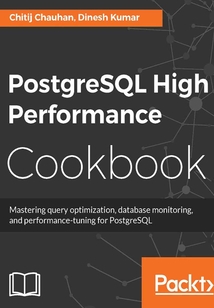舉報 

會員
PostgreSQL High Performance Cookbook
最新章節(jié):
Detecting a missing index
IfyouareadeveloperoradministratorwithlimitedPostgreSQLknowledgeandwanttodevelopyourskillswiththisgreatopensourcedatabase,thenthisbookisidealforyou.Learninghowtoenhancethedatabaseperformanceisalwaysanexcitingtopictoeveryone,andthisbookwillshowyouenoughwaystoenhancethedatabaseperformance.
目錄(135章)
倒序
- 封面
- 版權(quán)信息
- Credits
- About the Authors
- About the Reviewers
- www.PacktPub.com
- Customer Feedback
- Preface
- Chapter 1. Database Benchmarking
- Introduction
- CPU benchmarking
- Memory benchmarking
- Disk benchmarking
- Performing a seek rate test
- Working with the fsync commit rate
- Checking IOPS
- Storage sizing
- Discussing RAID levels
- Configuring pgbench
- Running read/write pgbench test cases
- Chapter 2. Server Configuration and Control
- Introduction
- Starting the server manually
- Stopping the server quickly
- Stopping the server in an emergency
- Reloading server configuration
- Restarting the database server quickly
- Tuning connection-related parameters
- Tuning query-related parameters
- Tuning logging-related parameters
- Chapter 3. Device Optimization
- Introduction
- Understanding memory units in PostgreSQL
- Handling Linux/Unix memory parameters
- CPU scheduling parameters
- Disk tuning parameters
- Identifying checkpoint overhead
- Analyzing buffer cache contents
- Chapter 4. Monitoring Server Performance
- Introduction
- Monitoring CPU usage
- Monitoring paging and swapping
- Tracking CPU consuming processes
- Monitoring CPU load
- Identifying CPU bottlenecks
- Identifying disk I/O bottlenecks
- Monitoring system load
- Tracking historical CPU usage
- Tracking historical memory usage
- Monitoring disk space
- Monitoring network status
- Chapter 5. Connection Pooling and Database Partitioning
- Introduction
- Installing pgpool-II
- Configuring pgpool and testing the setup
- Installing PgBouncer
- Connection pooling using PgBouncer
- Managing PgBouncer
- Implementing partitioning
- Managing partitions
- Installing PL/Proxy
- Partitioning with PL/Proxy
- Chapter 6. High Availability and Replication
- Introduction
- Setting up hot streaming replication
- Replication using Slony
- Replication using Londiste
- Replication using Bucardo
- Replication using DRBD
- Setting up a Postgres-XL cluster
- Chapter 7. Working with Third-Party Replication Management Utilities
- Introduction
- Setting up Barman
- Backup and recovery using Barman
- Setting up OmniPITR
- WAL management with OmniPITR
- Setting up repmgr
- Using repmgr to create replica
- Setting up walctl
- Using walctl to create replica
- Chapter 8. Database Monitoring and Performance
- Introduction
- Checking active sessions
- Finding out what the users are currently running
- Finding blocked sessions
- Dealing with deadlocks
- Table access statistics
- Logging slow statements
- Determining disk usage
- Preventing page corruption
- Routine reindexing
- Generating planner statistics
- Tuning with background writer statistics
- Chapter 9. Vacuum Internals
- Introduction
- Dealing with bloating tables and indexes
- Vacuum and autovacuum
- Freezing and transaction ID wraparound
- Monitoring vacuum progress
- Control bloat using transaction age
- Chapter 10. Data Migration from Other Databases to PostgreSQL and Upgrading the PostgreSQL Cluster
- Introduction
- Using pg_dump to upgrade data
- Using the pg_upgrade utility for version upgrade
- Replicating data from other databases to PostgreSQL using Goldengate
- Chapter 11. Query Optimization
- Introduction
- Using sample data sets
- Timing overhead
- Studying hot and cold cache behavior
- Clearing the cache
- Query plan node structure
- Generating an explain plan
- Computing basic cost
- Running sequential scans
- Running bitmap heap and index scan
- Aggregate and hash aggregate
- Running CTE scan
- Nesting loops
- Working with hash and merge join
- Grouping
- Working with set operations
- Working on semi and anti joins
- Chapter 12. Database Indexing
- Introduction
- Measuring query and index block statistics
- Index lookup
- Comparing indexed scans and sequential scans
- Clustering against an index
- Concurrent indexes
- Combined indexes
- Partial indexes
- Finding unused indexes
- Forcing a query to use an index
- Detecting a missing index 更新時間:2021-07-09 18:47:42
推薦閱讀
- 大數(shù)據(jù)導(dǎo)論:思維、技術(shù)與應(yīng)用
- SCRATCH與機(jī)器人
- R Machine Learning By Example
- Hands-On Neural Networks with Keras
- CorelDRAW X4中文版平面設(shè)計50例
- Mastering Machine Learning Algorithms
- 精通特征工程
- 大數(shù)據(jù)技術(shù)與應(yīng)用
- RPA(機(jī)器人流程自動化)快速入門:基于Blue Prism
- Linux服務(wù)與安全管理
- 網(wǎng)絡(luò)安全與防護(hù)
- Kubernetes for Serverless Applications
- Deep Reinforcement Learning Hands-On
- 激光選區(qū)熔化3D打印技術(shù)
- 零起點學(xué)西門子S7-200 PLC
- 云計算和大數(shù)據(jù)的應(yīng)用
- 精通LabVIEW程序設(shè)計
- Flink原理與實踐
- 經(jīng)典Java EE企業(yè)應(yīng)用實戰(zhàn)
- 中國戰(zhàn)略性新興產(chǎn)業(yè)研究與發(fā)展·數(shù)控系統(tǒng)
- 計算機(jī)組裝與維修實訓(xùn)
- Windows 7故障與技巧200例
- Deep Learning Essentials
- Oracle 11g基礎(chǔ)與提高
- Flink內(nèi)核原理與實現(xiàn)
- 嵌入式系統(tǒng)原理與應(yīng)用設(shè)計
- 自動化生產(chǎn)線裝配與調(diào)試技術(shù)-:基于西門子S7-200系列PLC
- R Graph Essentials
- Visual Basic.NET+SQL Server全程指南
- 網(wǎng)站分析實戰(zhàn)

